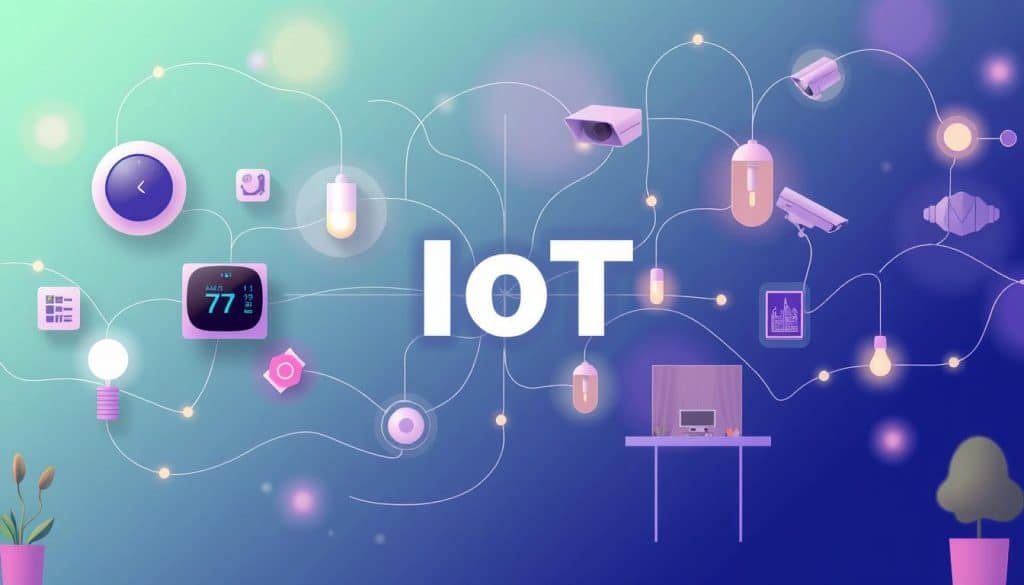Did you know the global IoT market is set to hit $1.39 trillion by 2027? But, IoT integration can be hard for those who aren’t tech-savvy. It’s important to make it easier for everyone to use smart tech.
In this guide, we’ll look at ways to make IoT easier for everyone. We’ll cover common problems and how to solve them. You’ll learn about tools and platforms that are easy to use. Our aim is to help you use smart tech in your daily life and work.

Key Takeaways
- The global IoT market is projected to reach $1.39 trillion by 2027, highlighting the growing importance of simplifying IoT integration.
- Discover strategies to overcome common barriers for non-technical teams in adopting IoT technologies.
- Explore user-friendly, drag-and-drop solutions for effortless IoT device management and automation.
- Learn best practices for creating intuitive IoT platforms that empower non-technical users.
- Understand the benefits of visual programming interfaces, template-based solutions, and effective error prevention and handling.
Understanding the Challenges of IoT Implementation
Putting IoT solutions into action can be hard, even for teams that aren’t tech-savvy. As IoT grows fast, companies face many hurdles. These can stop them from using these new techs well. We’ll look at common problems, the money side of complex setups, and old vs. new ways to connect things.
Common Barriers for Non-Technical Teams
For teams not into tech, learning about IoT is tough. They don’t get the tech details, like how devices talk to each other and keep data safe. It’s hard to deal with all the IoT stuff out there, leading to problems and delays.
The Cost of Complex Integration
Getting IoT up and running costs a lot of money. It includes things like special software, hardware, and upkeep. This can scare off small and medium-sized businesses. Figuring out IoT costs can be a big challenge for non-tech teams.
Traditional vs. Modern Integration Approaches
Old ways of connecting IoT need a lot of tech know-how and custom work. These methods are hard for non-tech teams to handle. But, new tools and platforms are coming out. They make it easier and cheaper for everyone to use IoT.
“The complexity of IoT integration can be a major roadblock for non-technical teams, but modern solutions are paving the way for more accessible and cost-effective IoT adoption.”
Drag-and-Drop Solutions for IoT Device Management
Managing IoT devices can be hard, but drag-and-drop tools make it easy. These tools help people set up and control their IoT systems without needing to know how to code.
Drag-and-drop tools are simple to use. They let users arrange devices and rules by dragging and dropping. This makes it easy for anyone to manage their IoT devices.
These tools also come with pre-made templates and triggers. This means users can quickly set up their IoT systems. It makes using IoT devices easier for more people.
Drag-and-drop tools have changed how we manage IoT devices. They let non-technical users control their systems. This leads to better efficiency, cost savings, and makes IoT more accessible.
“Drag-and-drop solutions have truly revolutionized IoT device management, making it possible for anyone to create and configure their smart environments with ease.”

Automated Workflows: Making IoT Integration Effortless
IoT integration can be hard for those who aren’t tech-savvy. But, automated workflows make it easy. They let users connect their IoT devices smoothly. This opens up a world of easy IoT integration.
Building Custom Automation Rules
Automated workflows let users make custom automation rules. These rules set up actions based on what happens. For example, lights can turn on when someone walks in. This lets non-tech users control their IoT setup.
Trigger-Based Actions and Responses
Automated workflows bring a new way to connect IoT devices. Users set up triggers and actions. This means devices respond quickly without needing a person to do it. It makes using IoT devices easy and reliable.
Monitoring and Analytics Made Simple
Watching how an IoT system works can be hard. But, automated workflows make it simple. Users get tools to see how their system is doing. This helps them make their automated workflows better and get more from their IoT.

“Automated workflows are the key to unlocking the full potential of IoT integration for non-technical users. By simplifying the process and providing intuitive tools, we’re empowering everyone to harness the power of connected devices.”
Simplifying IoT Integration for Non-Technical Users
The Internet of Things (IoT) is changing many industries. It’s important to make it easy for everyone to use, even those who aren’t tech-savvy. I’ll share ways to make IoT easier for everyone.
User-centric design is key. Making IoT systems easy for non-tech users helps a lot. This means simple interfaces, clear instructions, and easy setup.
Visual programming interfaces are also great. They let users connect devices and create workflows easily. No need for coding skills.
Pre-built templates and integrations are helpful too. They’re ready for certain tasks, making it easy for users to start without a lot of work.
Good error prevention and handling is important. It helps users avoid problems and solve them easily. This makes using IoT systems better for everyone.
Using these ideas, IoT can be more accessible to all. This will help more people use it, making it even better.
Best Practices for User-Friendly IoT Platforms
To make IoT easy for everyone, we need simple and easy-to-use platforms. We should use visual tools, templates, and help prevent mistakes. This way, even beginners can use connected devices easily.
Visual Programming Interfaces
Drag-and-drop tools make setting up IoT simple. They let users connect devices and set up rules without coding. This makes IoT easy for all, not just tech experts.
Template-Based Solutions
Pre-made templates make things easier. They help users start quickly, without having to start from scratch. This helps more people use IoT and get good results.
Error Prevention and Handling
It’s key to have a platform that doesn’t crash often. We need clear messages and ways to fix problems. This makes users feel confident and helps them use IoT without stress.
FAQ
What are the common barriers for non-technical teams when implementing IoT solutions?
Non-technical teams often find it hard to integrate IoT. They worry about the cost and learning to use IoT devices.
How can drag-and-drop solutions simplify IoT device management?
Drag-and-drop solutions make it easy to manage IoT devices. You don’t need to know how to code. It’s simple to set up and use.
What are the benefits of automated workflows for IoT integration?
Automated workflows make IoT integration easier. They let you create rules and actions. This makes IoT systems work better for everyone.
What are some best practices for developing user-friendly IoT platforms?
To make IoT platforms easy to use, add visual interfaces and templates. Also, make sure there are ways to handle errors. This makes using IoT simple for everyone.

